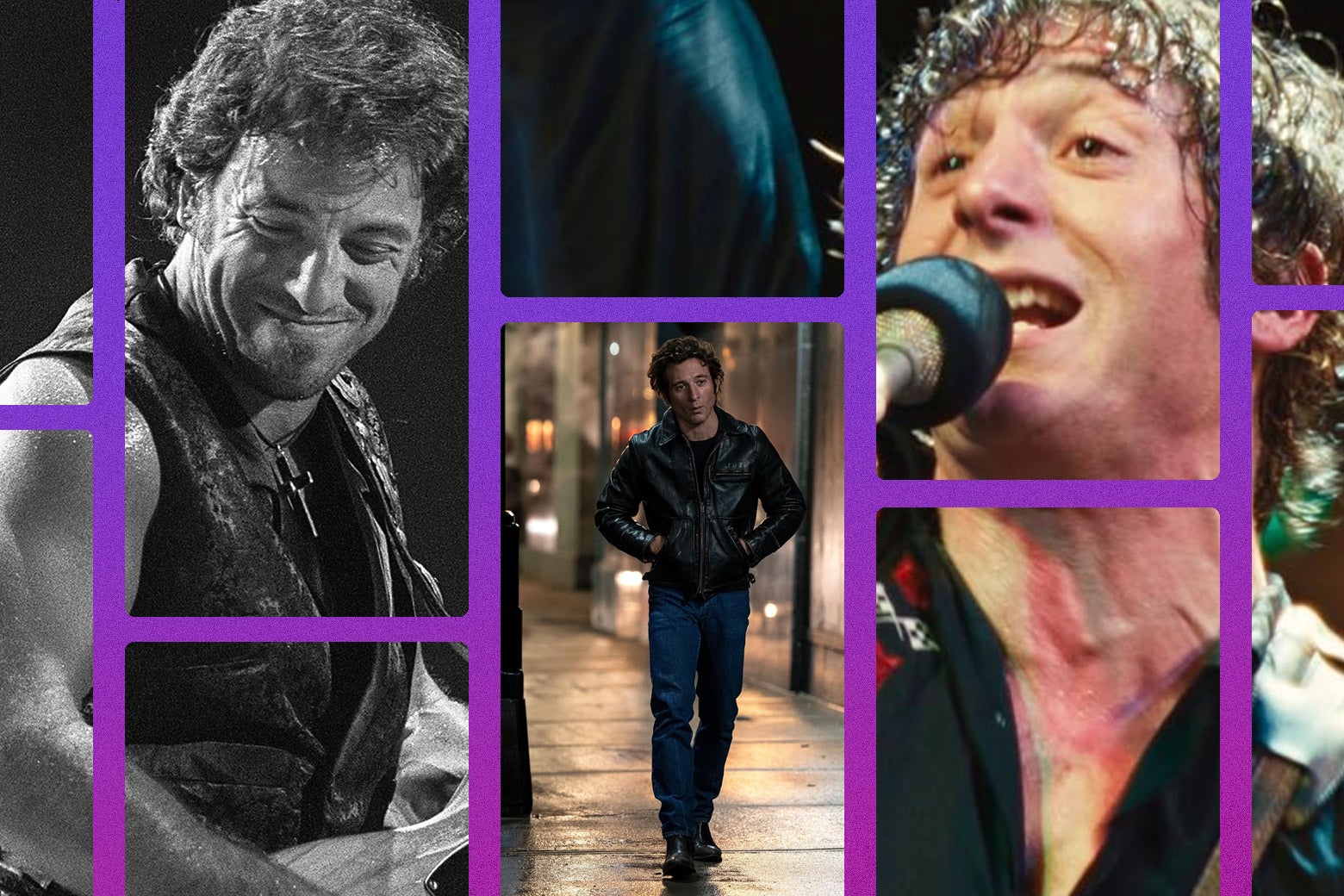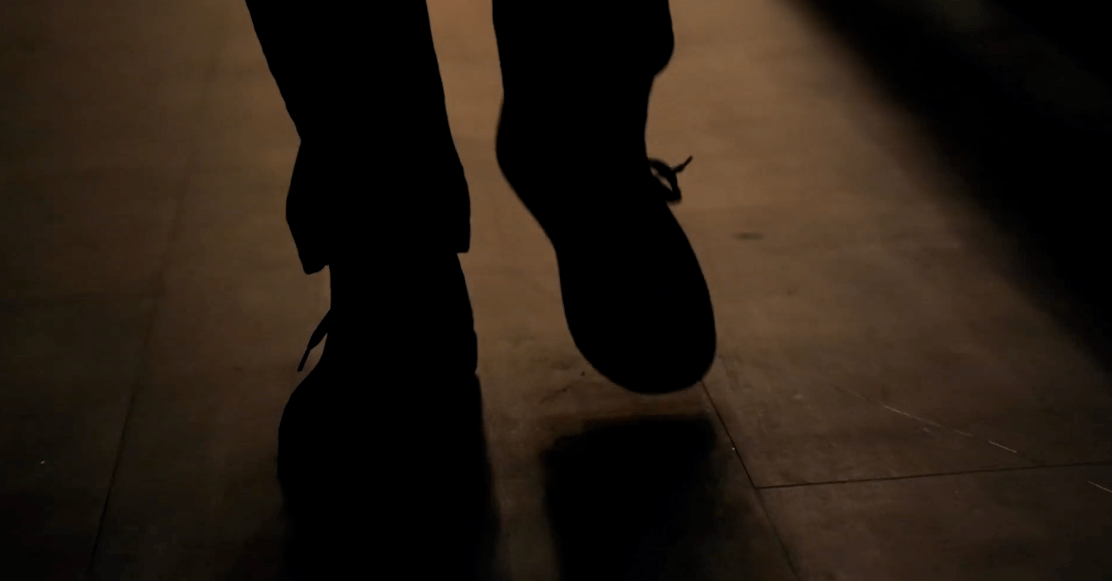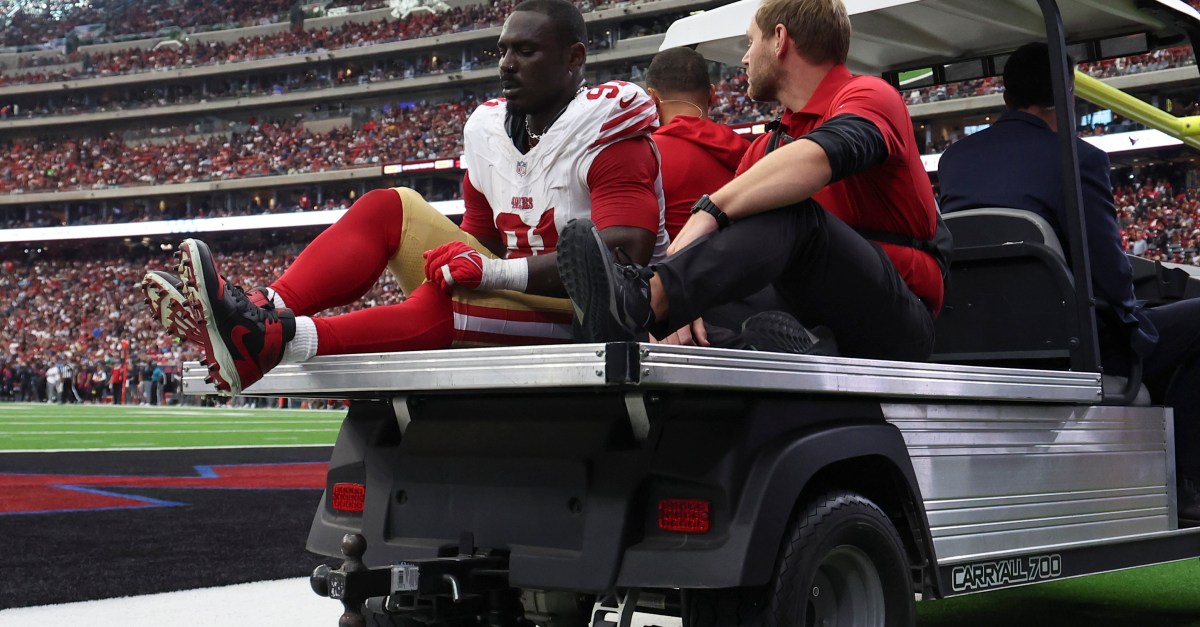This article is part of Portrait Mode, a Slate pop-up series about biopics.
People often paint the suits at Columbia Records as the doubters, even though they didn’t really put up much of a fight. But there also must have been a lot of Bruce Springsteen fans who hated Nebraska when the album came out in 1982. Here was a rock star who’d been gathering up believers for a decade with his sprawling social narratives, a larger-than-life rock-and-soul band, and his epic stage shows. He’d just had his first Top 10 hit with the chiming, radio-friendly “Hungry Heart,” reaping hordes of fresh devotees. Then he put out a warbly tape he literally made in his New Jersey bedroom, of what sounded like prewar acoustic country-blues songs about gamblers, killers, vagrants, and other lost losers. Recordings he hadn’t originally intended to be an album. And the rollout strategy? No singles, no tours, no press. His face wasn’t even on the cover. A good-size minority of Bruce-heads must have grumbled, as Rolling Stone’s Greil Marcus famously did of Bob Dylan’s 1970 Self-Portrait, “What is this shit?”
In fact, I bet there still are lots of Springsteen fans who dislike Nebraska. People who understandably prefer the bright, rousing “Born” records—the earlier Born to Run, the soon-to-come Born in the U.S.A.—over this bad-sounding bummer so shadowed by death. They won’t say it in public now because Nebraska has become too much a part of the myth. It’s perhaps Springsteen’s most critically adored album and in some senses his most influential. Personally, it was the one that first won me over, as a teen skeptic of celebrity and masculine bombast. Beyond Springsteen’s own work, Nebraska became a byword for the heroic artistic left turn. But logically the haters have to be out there too.
The worst thing I can say about writer-director Scott Cooper’s new biopic about the making of Nebraska is that I can’t imagine people bothering to love or to hate it that much. Springsteen: Deliver Me From Nowhere is a worthy try at the nearly impossible task of depicting cinematically an artist making a deeply interior turn. It’s daring to make a movie that’s mostly about a guy making a tape in a room. But its only real courage is in that attempt, not in its own content or form. It tells its unlikely story in the most likely way it can: This is the kind of film in which the rising star is recognized by a car salesman who says, “I know who you are,” and the protagonist answers, “Well, that makes one of us.” And so despite its best intentions it inevitably betrays the thing it was meant to honor. If only it had the nerve to be hated.
To make the right movie about Nebraska, you’d have to find a cinematic language that startled audiences as much as the album once did. There are feints in that direction when Deliver Me breaks up its 1980s color scenes with black-and-white flashbacks to Springsteen’s 1950s childhood with his mentally unwell, sometimes abusive father. But that’s still pretty conventional. (The opposite use of hues might have been closer to the singer’s mental state in 1981–82—his past feeling more vivid than his present.) There’s also one flash of near-Lynchian imagery in a late scene of psychological crisis, but it’s so belated and brief it feels clumsy.
The movie’s in-betweenness is kind of a match for the Nebraska ’82: Expanded Edition box set Sony Music issued today in step with the film. It is part of the mounting pile of outtakes and alternate tracks and even whole “lost albums” Springsteen has been releasing in his graying years. The big headline here is about the long-rumored “Electric Nebraska” set, the versions of the songs Springsteen rehearsed and cut with E Street Band members in the studio before getting frustrated and deciding he should just release the so-called demos. Predictably, they’re not as bad as he’d thought—this version would have been strong too, a kind of punk-rockabilly rendition. But it wouldn’t have been Nebraska. Like the movie, it would have been only halfway there.
Too bad, because there’s nothing middling about Warren Zanes’ 2023 book Deliver Me From Nowhere, on which the film is based. It’s one of the most compelling making-of accounts I’ve ever read, grippingly juggling biography, criticism, cultural and technological history, and showbiz scuttlebutt. I can see exactly why the producers had the impulse to adapt it, but not why they didn’t see the central problem: Rather than its scenes or even its one-on-one interviews with Springsteen and others, the book’s momentum lies in Zanes’ guiding voice, influenced in part by his own experience as a working musician in the 1980s band the Del Fuegos. (In the prologue, he describes the night Springsteen showed up unannounced in their dressing room at a club in Greensboro in 1985 and ended up joining them onstage.) As usual with almost any biopic, I suspect it all would have worked better as a documentary.
Instead, with no other device to provide that overarching perspective, Zanes’ words end up springing from the mouths of various characters as stilted exposition. Most often that’s from Springsteen’s producer-manager Jon Landau as played by Jeremy Strong (from Succession). When Cooper really needs to shoehorn in some insight into Springsteen’s artistic method or emotional turmoil, he just has Landau yammer it to his wife (Grace Gummer, who gets nothing else to do).
Maybe the Landau character could have served as an actual narrator, but half-playing that function gets in the way of Strong’s performance and the potential for the pair’s relationship as the heart of a film that really needs one. As Zanes says in the book, the partnership is one of the most remarkable in music, with Springsteen having recruited Landau out of rock criticism in the 1970s to serve as impresario, confidant, and dramaturge for his albums and career ever since. But that’s left for someone else to illuminate. This film gives us Landau only as Bruce’s monkish protector and sometime goad, no more sense of him as a person. (Maybe he could have used some flashbacks.) It makes Strong’s well-known “Method” intensity feel mannered, and often at odds stylistically with the looser naturalism of Jeremy Allen White (from The Bear, and the underwear ads) as a not-so-bossy Boss. Somehow even the occasional glimpses of Springsteen’s bond with his New Jersey mechanic friend Matt feel more intimate.
White is undeniably good, never forcing a Springsteen impression and yet rising to sing and play the songs with accuracy and passion, skills he acquired for the film, starting from zero. The goal, the team has said, was to make a movie about a musician in a specific situation who just happened to be Bruce Springsteen. But it’s there that the movie slams into the giant obstacle for biopics in the 2020s about living people, especially about living artists: White just happens not to be Bruce Springsteen, and if you are at all interested in that guy, you’ve already been able over the past couple of decades to experience hours and hours of him up close. In multiple self-produced documentaries of him in studios and on tours, in countless interviews, and even in his own podcast. Not to mention at his one-man Broadway show or in the Netflix film thereof. You might also have read his story in his own words in his hefty autobiography, alongside Zanes’ book and all the others. And of course he and Landau oversaw this movie too, so it’s not as if you’re going to hear anything they don’t want said.
There was a time when music biopics told scandalous lies, or at least unfolded behind-the-scenes stories audiences actually had no other access to. Now I more often wish those stories would shut up and let the artworks speak. This excess familiarity makes it hard ever to forget you are watching an actor pretend to be this other person whose tone and movements and particular charisma are so familiar. Even when the actor generates his own, different charisma as skillfully as White does.
The very worst of this is in the early scene when the E Street Band is supposed to be finishing a triumphant performance of “Born to Run” on stage in Cincinnati; the group looks like a bunch of acting students putting on a school play about a rock band, not a posse of veteran Jersey road dogs. Thankfully they don’t try that again. (The band comes off much better in the studio, although weirdly they’re barely given any lines, not even the actor playing Springsteen’s other close confidant, Steven Van Zandt.) But White is always suppler and prettier than the Bruce we know, his brooding more poetic than the actual poet’s twitchy ways, never so hungry.
To make the obligatory comparison, the same was true of Timothée Chalamet as Bob Dylan in last year’s A Complete Unknown. But the advantage Chalamet had there is that Dylan, no matter how much he’s been documented, always will be a cryptic, withholding enigma. There’s always a blank space an actor can try to fill in. (That’s even the thesis of that rare formally radical biopic, Todd Haynes’ brilliant I’m Not There.) Back in 1982, that might have been true of onetime “New Dylan” Springsteen too, but it hasn’t been for a long while now. The beguiling 2019 feature Blinded by the Light solved this problem by looking at the Springsteen phenomenon via the true story of one of his fans, a British-Indian immigrant kid who improbably discovered his own reflection in the music of a white Yankee. That distance makes it a more effective appreciation.
Deliver Me does get one part of the biopic dilemma right: It avoids the easily parodied rise-and-fall clichés of the genre by zooming in on a small slice of its subject’s life, even a smaller one here than in A Complete Unknown. But that movie was built around one grand scene: the “going electric” moment at the 1965 Newport Folk Festival, in which young Bobby stands before his disciples and betrays them with a feedback-soaked kiss, and they turn on him en masse. Sure, it may not actually be true, but it is cinematic, and the movie was plotted backward to lead to that moment.
What’s the parallel here? Maybe it’s when, after weeks of effort, an engineer finally figures out how to fiddle with the mastering equipment so that a listenable copy can be made from the distorted Nebraska tape. I really was excited by that part, but I am very nerdy. More generously, it’s in the bruise-tender, even painfully funny late scenes of reconciliation between Bruce and his now aged (and diagnosed and medicated) father. The great British actor Stephen Graham embodies Douglas Springsteen with extraordinary grace. But these are small moments. The biggest musical thrill is when the band performs “Born in the U.S.A.” live in the studio, so different from on Springsteen’s demo, with Max Weinberg’s unmistakable gated snare sound echoing over their heads (and an incredible vocal performance by White). But that’s not a story about the making of Nebraska. It’s about what Springsteen was avoiding, the making of the next album, though that wasn’t clear yet. It’s a film that feels as if it has many endings, and also many middles, several of them a bit boring.
I’m not saying a movie about a musician needs such a widescreen moment or sweeping arc. Part of me wants to cheer rather than laugh at the times when the film (and its rather redundant score by Jeremiah Fraites of the Lumineers) acts as if it’s highly dramatic when Springsteen changes a set of lyrics from third to first person in his notebook. (Because it was!) Or how it ticks off boxes to show that he was influenced by the films Badlands and The Night of the Hunter and the short stories of Flannery O’Connor. But often it seems like the slideshow-lecture version of Zanes’ book, like an explainer video. I’m not sure how it would play for anyone not already invested in Springsteen and his music, whereas for A Complete Unknown that seems to be an advantage.
I feel unsure whether the film is trying to draw a causal link between Nebraska’s dour music and Springsteen’s own slide into depression, which is brought on by his conflicted, resistant feelings about stardom separating him from his roots, yes, but also by the chemical imbalances he inherited from his father. Sometimes creative choices and compulsive forces really are that entangled. But I don’t think the film finds a way to immerse us in those contradictions, rather than observing them at a remove. I got stronger feelings from watching White lie on the floor listening to Suicide’s “Frankie Teardrop” than I did from most of the ways the film used the actual songs from Nebraska.
A (composite) love interest is wedged in mostly for love interest’s sake. But on Bruce’s dates with the charming Odessa Young as Jersey diner waitress Faye, at least he gets some air, and we get to poke around Asbury Park. Their relationship directly conveys his inability at the time to get a life or to keep it. Of course, she gets expository herself when they, inevitably, break up, but at least she nails some of his character traits untouched by all the flashbacks and Landau’s artist-splaining.
But the film also makes many subtractions. A few are personal—his sisters, his grandparents, and other elements of his early life that made him not just wounded and sensitive but driven, expansive, even entitled, leading to a fate different from his dad’s. More crucially, it omits the Reagan-era political context of Nebraska: Cooper tells us that Springsteen was reading O’Connor but not that he was reading Howard Zinn. While Springsteen was writing and recording Nebraska in 1981 and 1982, the U.S. was in its worst postwar economic recession before the 2008 financial crisis. Meanwhile the new government was shredding all kinds of safety nets and regulations. Reagan’s anti-Soviet rhetoric also spiked fears of nuclear war. The feeling of upheaval was not so different from 2025.
Springsteen could not yet make his shiny, loud album of hits not only because he feared what mega-success would mean, but because he first needed to make it clear which side he was on, with the poor and desperate characters of Nebraska. His sense of self always has been entangled with that of the country and the times. There’s a reason his biggest song is called “Born in the U.S.A.” He views America’s story and his own as metaphors for each other, his depressive tendencies being counterbalanced by a grandeur you’d call delusional if he hadn’t ended up kinda earning it.
Unlike Zanes’ book, Cooper’s movie seems completely uninterested in that half of the picture. It will show us old movies on Bruce’s TV, but never the news. Similarly, the standard title cards at the end tell us that Nebraska got to No. 3 on the charts and therapy helped with his depression, but nothing of the album’s longer legacy. Not only for what Springsteen himself would represent, but in creating lasting templates for both creative risk and savvy career strategies—from every “lo-fi” artist who recorded on four-tracks and boom boxes (like Guided by Voices, early Liz Phair, Elliott Smith, the Mountain Goats, eventually Bon Iver) or just sounded like it to MTV “Unplugged” sessions and even Taylor Swift’s Folklore. Not to mention the way the digital work stations that succeeded home taping truly dethroned the traditional studio. Maybe a little credit-roll documentary montage could have conveyed some of that story—certainly it’d be more meaningful than the closing long shots of White gazing manfully out upon the Jersey shore.
Springsteen fans will watch it anyway. And they should, for the performances and the many minor grace notes. But when I hear talk of a sequel, meaning the further transfiguration of Springsteen into yet another burnin’ hunk of franchise IP? Lord, deliver us.
First Appeared on
Source link













